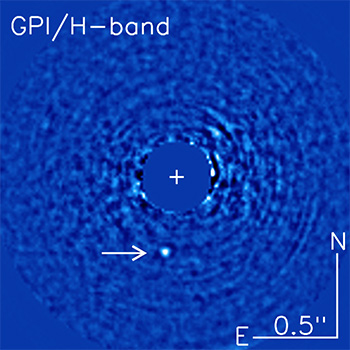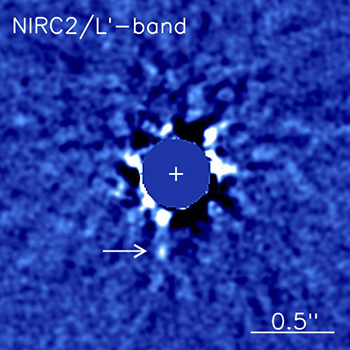An international team of astronomers has discovered a Jupiter-like planet within a young system that could serve as a decoder ring for understanding how planets formed around our sun. Five UC Santa Cruz astronomers were involved in the discovery, reported in the August 13 online edition of the journal Science.
Claire Max, professor of astronomy and astrophysics and director of UC Observatories, led observations at the W. M. Keck Observatory that confirmed the findings, after the planet was initially detected by the Gemini Planet Imager. This is the first exoplanet discovered by the Gemini Planet Imager, which was assembled and tested at UC Santa Cruz before being shipped to Chile for installation on the Gemini South Telescope. The instrument was designed specifically for discovering and analyzing faint, young planets orbiting bright stars.
While NASA's Kepler space observatory has discovered thousands of planets, it does so indirectly by detecting a loss of starlight as a planet passes in front of its star. The Gemini Planet Imager searches for light from the planet itself.
"To detect planets, Kepler sees their shadow. The Gemini Planet Imager instead sees their glow, which we refer to as direct imaging," said Bruce Macintosh of Stanford University, who led the collaboration.
Max and UC Santa Cruz graduate student Alex Rudy used the NIRC2 camera at Keck to observe the planet in wavelengths of light not seen by the Gemini instrument. "Observations using the NIRC2 camera and adaptive optics system at the Keck Observatory allowed the GPI team to independently verify the existence of the planet," Macintosh said. "NIRC2 can observe at longer infrared wavelengths than GPI, where a cool planet like 51 Eri b is brighter. These longer-wavelength observations helped to measure the properties of clouds in the planet's atmosphere that absorb and re-radiate infrared emission."
Young star
The host star, 51 Eri, is very young, a mere 20 million years old, and is slightly hotter than the Sun. The exoplanet 51 Eri b, whose mass is estimated to be roughly twice that of Jupiter, appears to orbit its host star at a distance 13 times greater than the Earth-Sun distance. If placed in our own solar system, 51 Eri b's orbit would lie between those of Saturn and Neptune.
As far as the cosmic clock is concerned, 20 million years is young, and that is exactly what made the direct detection of the planet possible. When planets coalesce, material falling into the planet releases energy and heats it up. Over the next hundred million years the planet radiates that energy away, mostly as infrared light.
In addition to being the lowest-mass planet ever imaged, it's also one of the coldest—800 degrees Fahrenheit, whereas others are around 1,200 F—and features the strongest atmospheric methane signal on record. Previous Jupiter-like exoplanets have shown only faint traces of methane, far different from the heavy methane atmospheres of the gas giants in our solar system.
"In the atmospheres of the cold giant planets of our solar system, carbon is found as methane, unlike most exoplanets, where carbon has mostly been found in the form of carbon monoxide," said Mark Marley, an astrophysicist at NASA Ames Research Center. "Since the atmosphere of 51 Eri b is also methane rich, it signifies that this planet is well on its way to becoming a cousin of our own familiar Jupiter."
A young Jupiter
All of these characteristics, the researchers say, point to a planet that is very much what models suggest Jupiter was like in its infancy. Of course, it's not exactly like Jupiter—its 800 F temperature is still hot enough to melt lead—but there are signs it will evolve into a familiar shape.
In addition to expanding the universe of known planets, the Gemini Planet Imager will provide key clues as to how solar systems form. Astronomers believe that the gas giants in our solar system formed by building up a large core over a few million years and then pulling in a huge amount of hydrogen and other gases to form an atmosphere.
But the Jupiter-like exoplanets that have so far been discovered are much hotter than models have predicted, hinting that they could have formed much faster as material collapses quickly to make a very hot planet. This is an important difference. The core-buildup process can also form rocky planets like Earth; a fast and hot collapse might only make giant gassy planets. 51 Eri b is young enough that it "remembers" its formation.
In addition to Max and Rudy, other UC Santa Cruz coauthors of the paper include Jonathan Fortney, professor of astronomy and astrophysics, and postdoctoral fellows Michael Line and Sloane Wiktorowicz.




